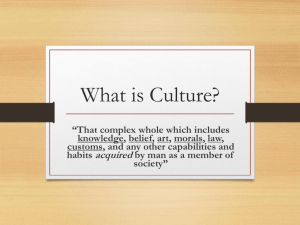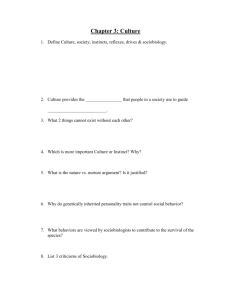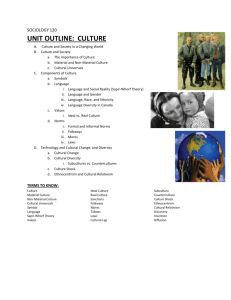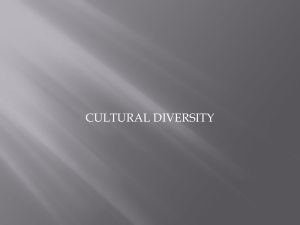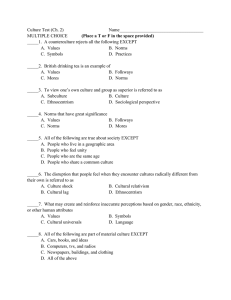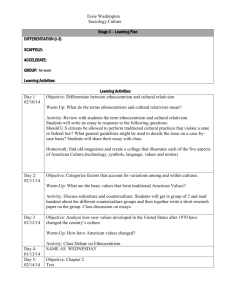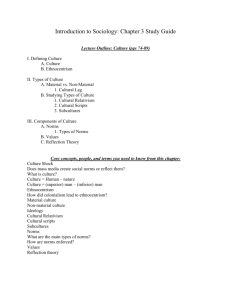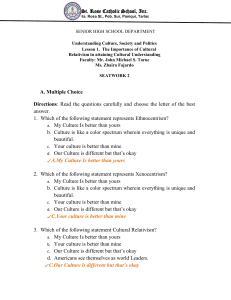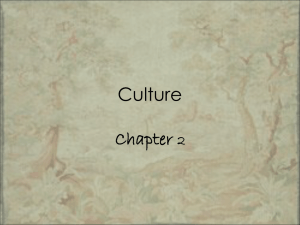Sociology Unit 3 Multiple Choice Test
advertisement
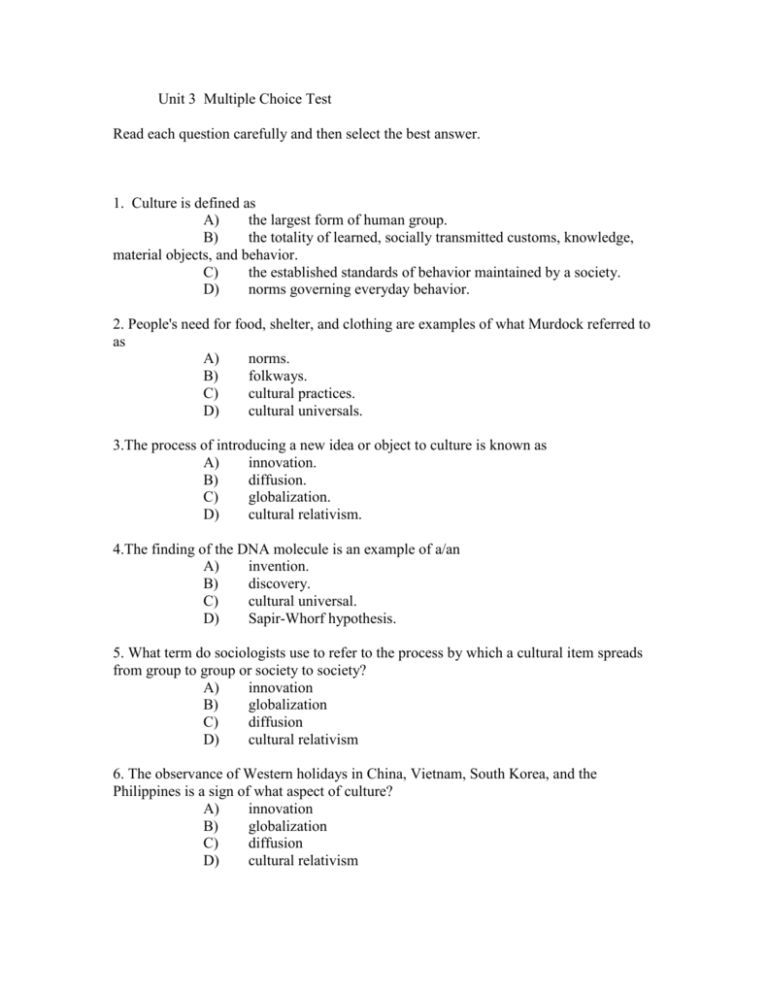
Unit 3 Multiple Choice Test Read each question carefully and then select the best answer. 1. Culture is defined as A) the largest form of human group. B) the totality of learned, socially transmitted customs, knowledge, material objects, and behavior. C) the established standards of behavior maintained by a society. D) norms governing everyday behavior. 2. People's need for food, shelter, and clothing are examples of what Murdock referred to as A) norms. B) folkways. C) cultural practices. D) cultural universals. 3.The process of introducing a new idea or object to culture is known as A) innovation. B) diffusion. C) globalization. D) cultural relativism. 4.The finding of the DNA molecule is an example of a/an A) invention. B) discovery. C) cultural universal. D) Sapir-Whorf hypothesis. 5. What term do sociologists use to refer to the process by which a cultural item spreads from group to group or society to society? A) innovation B) globalization C) diffusion D) cultural relativism 6. The observance of Western holidays in China, Vietnam, South Korea, and the Philippines is a sign of what aspect of culture? A) innovation B) globalization C) diffusion D) cultural relativism 7. What term did William Ogburn introduce to refer to the period of maladjustment when the nonmaterial culture is still adapting to new material conditions? A) culture lag B) cultural relativism C) ethnocentrism D) diffusion 8. Which one of the following statements is true according to the Sapir-Whorf hypothesis? A) Language simply describes reality. B) Language does not transmit stereotypes related to race. C) Language precedes thought. D) Language is not an example of a cultural universal. 9. The statement, "Respect your elders," reflects which one of the following? A) diffusion B) cultural universals C) ethnocentrism D) norms 10. In the United States, we often formalize norms into A) ideals. B) folkways. C) laws. D) values. 11. Standards of proper dress are a common example of which one of the following? A) informal norms B) sanctions C) values D) formal norms 12. Patterns of male dominance are reinforced in many societies around the world by A) mores. B) values. C) folkways. D) sanctions. 13. Health, love, and democracy are examples of A) mores. B) values. C) folkways. D) sanctions. 14Which theoretical perspective maintains that stability requires a consensus and the support of society's members? A) B) C) D) conflict theory interactionist theory social control theory functionalist theory 15. Which view of culture became popular in sociology in the United Stated beginning in the 1950s? A) conflict theory B) interactionist theory C) social control theory D) functionalist theory 16. Which one of the following statements is true from a conflict perspective? A) Stability requires a consensus and the support of a society's members. B) Cultural traits all work toward stabilizing society. C) A common culture serves to maintain the privileges of certain groups. D) Practices such as prostitution continue to survive because they contribute to the overall social stability. 17. Which one of the following terms describes the set of cultural beliefs and practices that help to maintain powerful social, economic, and political interests? A) mores B) dominant ideology C) consensus D) values 18. Which of the following life goals has shown the strongest gain in popularity for firstyear college students in the United States from 1966-2002? A) developing a meaningful philosophy of life B) helping to promote racial understanding C) helping others D) being very well-off financially 19, An American touring different parts of China wants local meat for dinner, but is shocked to learn that the specialty in one restaurant is dog meat. This illustrates A) counterculture. B) dominant ideology. C) a cultural universal. D) culture shock. 20. Terrorist groups are examples of A) cultural universals. B) subcultures. C) countercultures. D) dominant ideologies. 21. What term do sociologists use to refer to a segment of society that shares a distinctive pattern of mores, folkways, and values that differs from the pattern of the larger society? A) dominant culture B) counterculture C) subculture D) superculture 22. Anyone who feels disoriented, uncertain, out of place, even fearful, when immersed in an unfamiliar culture may be experiencing A) culture lag. B) culture shock. C) cultural relativism. D) xenocentrism. 23. What is the term used when one places a priority on understanding other cultures, rather than dismissing them as "strange" or "exotic?" A) ethnocentrism B) culture shock C) cultural relativism D) xenocentrism 24. Which of the following is, in a sense, the reverse of ethnocentrism? A) culture lag B) culture shock C) cultural relativism D) D xenocentrism 25. Evaluating the practices of other cultures on the basis of our own perspective is referred to as: A) ethnocentrism B) culture shock C) cultural relativism D) xenocentrism

